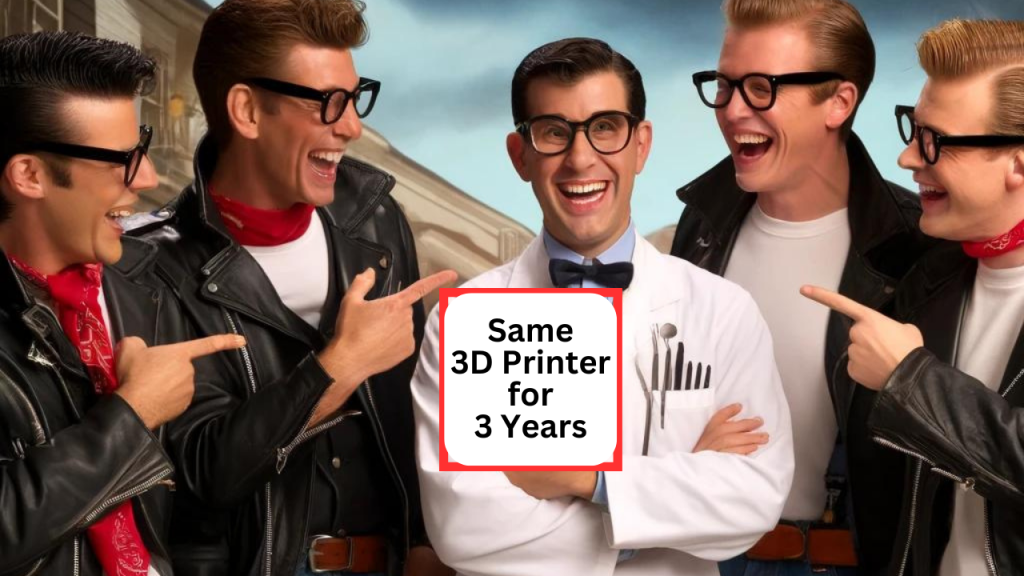The Growing Divide Between Dentists Who 3D Print

3D printing is making big waves in our profession. This technology lets dentists make all kinds of appliances, restorations, and prostheses right in the office instead of waiting for a dental lab to do it. It’s like having a mini-factory right at their fingertips. However, the adoption of this amazing new tech has been agonizingly slow and not all dentists think about 3D printing the same way, and this is causing a big split or divide in the blossoming world of dental 3D printing.
The Two Sides of Dentistry and 3D Printing
- The Early Adopters: Some dentists are just starting to learn about 3D printing. And, yes, they are still early adopters. Only about 15% of dentists have taken the plunge into this space as of this moment in time. These dentists are interested because it can help them take better care of their patients, save time, and spend less money on lab fees. Instead of outsourcing, which relegates control to the dental lab, they can do many things themselves right in their own office. These dentists like 3D printing because of the applications that are proven to work and aren’t too risky, i.e. models, dentures, clear aligners, surgical guides, and temporary crowns.
- The Gadget Lovers: Then there are the dentists who love trying the newest and coolest things, even if those things are still pretty new and not totally proven yet. These dentists want the latest 3D printing gadgets as soon as they come out. They’re excited to try new ways to help their patients, even if these ways haven’t been used by many people yet. Some people say these dentists have “shiny object syndrome” because they always want the newest, shiniest tools. Some of the best and brightest among us are in the category of loving gadgets. When I bought my first dental 3D printing in 2013, I was squarely in that category, as I was again when I bought my much faster printer in 2020. Back then, almost nobody was 3D printing and I had to really search to even find tutorial videos.
Why Is This Divide Happening?
The companies that make 3D printers are pushing this divide a bit.
When new dental resins started hitting the market for new and exciting applications around 2020, printers and curing units were sold with the promise that you could recoup your initial investment in a short amount of time and continue making a great ROI for a long time afterwards.
I was even told by a prominent reseller of 3D printing technology that the money wasn’t in the printers themselves, but in the recurring resin purchases. I found that refreshing and I was over the top excited at that time myself. I had been burned by my purchase of a prominent CAD/CAM milling system over a decade previously, not because it wasn’t amazing technology, but that the promises of possible ROI was quashed as the company came out with very expensive new equipment seemingly yearly, and I felt like I was getting locked out of providing the latest and greatest for my patients if I didn’t upgrade and spend even more money. My friends and I jokingly called it the *****-tax. I don’t want to publicly out the company, but I’m sure you can figure that one out. I became jaded and disappointed with that company almost as quickly as I had fallen in love with them due to my perception that they just wanted to squeeze as much money out of each dentist as humanly possible.
I came into 3D printing with the possibly naive idea that these people were different. I mean, the initial investment into 3D printing is still a fraction of the cost of the CAD/CAM milling systems of the past.
Fast forward to the present and the 3D printing companies keep making new and expensive equipment every year, hoping to attract dentists who want the latest tech. It sometimes feels like these companies are channeling Steve Jobs in the early days of Apple where seemingly every year, the greatest technological breakthrough of our times was happening with their launches of things like iPods, iPhones, and iPads. Then, as time moved on and Steve Jobs was no longer there, they still had these extravagant events to launch less and less innovative pieces of technology.
3D printing companies know that some dentists can’t resist trying out the newest tools. I’m no opponent of capitalism and I certainly don’t want to dissuade any dentist who wants to follow the amazing new tech that is being developed. I just want to see some degree of sanity as new tech comes on the scene.
I just don’t want the dentist who just wants to slowly get their feet wet in 3D printing for their patients to avoid the benefits to their practice because they are unsure.
This creates a real problem. The dentists who are careful and prefer using technology that has been tested and proven might have valid concerns. They don’t want to buy something that could become outdated quickly before they even get their money’s worth. This fear might stop them from using 3D printing at all, which means they miss out on all its great benefits like saving time, money, and improving patient care with methods that are already known to work well.
What Are the Benefits of Being Careful?
The more conservative dentists in this comparison are still early adopters, by the way, and light years ahead of the majority of dentists in the world. Being cautious doesn’t mean being behind the times. In fact, dentists who choose to use 3D printing technologies and procedures that have been around for a while are making a smart choice. These procedures are less risky because they have been tested over time, and lots of other dentists have seen good results with them. By choosing proven methods, these careful dentists can still enjoy all the benefits of 3D printing, like quicker treatment times and lower costs, without the worry of investing in something that might soon be out of date.
What About the Dentists Who Like New Technology?
Dentists who try out new technologies are also very important. They help the industry grow by testing new ideas and finding new ways to treat patients. Their willingness to take risks can lead to big breakthroughs in how dentistry is done. However, it’s important for these dentists to remember that not every new gadget is going to be a game-changer, and sometimes, these tools can come with problems that haven’t been seen yet.
There’s absolutely nothing wrong with wanting to get you money’s worth from one 3D printer before purchasing a new one that promises amazing things, but that remains unproven. That’s an area I hope the biggest companies will consider as they promote their new advancements, which do seem pretty amazing all the same.
The Real Winners in Dentistry
The truth is, both types of dentists are important. The ones who try new things keep pushing dentistry forward, and the ones who stick to what’s proven make sure that patient care stays safe and effective. The best path for any dentist thinking about 3D printing is to find a balance between trying new things and sticking with what works.
In the end, the real winner in dentistry is the approach that helps both the patients and the dental practice the most. Using 3D printing technology that has been proven over time offers a safe, cost-effective, and efficient way to improve how dental care is provided. This doesn’t mean ignoring new developments, but it does mean being smart about which technologies to adopt and when.
So, whether a dentist loves the latest gadgets or prefers sticking with the tried and true, the goal remains the same: to provide the best care possible in the most efficient and effective way. And with technologies like 3D printing becoming more common, the future of dentistry looks brighter and more exciting than ever to me.

